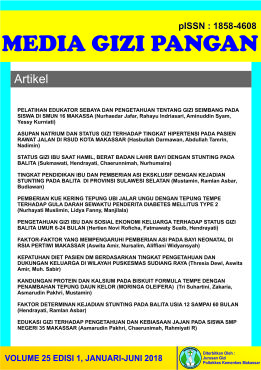HUBUNGAN BERAT LAHIR DENGAN KADAR ARAKIDONAT ACID PADA ASI DARI IBU MENYUSUI BAYI 1-4 BULAN DI KOTA MAKASSAR
DOI:
https://doi.org/10.32382/mgp.v30i2.307Kata Kunci:
Air Susu Ibu, Asam Arakidonat, Ibu Menyusui, BBLRAbstrak
Human milk is the most perfect food for babies, ideally breast milk is the only source of nutrition for six months at the beginning of life. This study aimed to assess the correlation levels of Arhacidonat Acid of breast milk in nursing mothers by birth weight (LBW and normal) in Makassar. Research conducted at the health center area of Makassar. This type of research is observational analytic with cross-sectional design. How the sample selection using purposive sampling of 30 people, where the first group of 15 lactating mothers of normal birth weight babies and a second group of 15 mothers breastfeeding LBW infants. Levels of Arhacidonat Acid is checked by HPLC (Hight Performance Liquid Chromotography). Data were analyzed using SPSS using independent t-test to see relations birth weight infants with higher levels of essential fatty acids in milk both groups. Average levels of AA breastfed babies with normal birth weight lower than the levels of AA breastfeeding LBW infants (0.098 ± 0.006 mg / ml appeal of 0.085 ± 0.024 mg / ml) but the relationship was not significant (P> 0.05). It was concluded that there was no association between birth weight infants with higher levels of Arhacidonat Acid breast milk in lactating mothers of infants aged 1-4 months in Makassar.
Referensi
Anneke, HT & Lestari, H. 2001. Peran Penambahan DHA pada Susu Formula. Sari Pediatri, Vol. 3, No. 3, Desember 2001: 147 - 151
Ballard, O. & Morrow, A.L. 2013. Human Milk Composition: Nutrients and Bioactive Factors. Pediatric Clinics of North America, 60, 49-74.
Beach, P., Revai, K. & Niebuhr, V. 2008. Nutrition [online]. Texas: Dept of Pediatrics, Univ. Texas Medical Branch. Available: http://www.utmb.edu/pedi_ed/core/nutrition/page_13.htm [accessed 9 August 2015].
Bhatia, J. 2007. Human Milk & The Premature Infant. Journal of Perinatology, 27:71-74.
Hamosh, M. 1996. Breastfeeding: Unraveling the Mysteries of Mother's Milk. Diakses 8 Juni 2015. Available: http://www.medscape.com/viewarticle/718175.
Horta, L. 2013. Long-term effects of breastfeeding. World Health Organisation.
IDAI. 2013. Pemberian asi pada bayi lahir kurang bulan [online]. Ikatan dokter anak indonesia. Available: http://idai.or.id/public-articles/klinik/asi/pemberian-asi-pada-bayi-lahir-kurang-bulan.html [accessed 11 August 2015].
Iranpour, R. 2013. Comparison Of Long Chain Polyunsaturated Fatty Acid Content In Human Milk In Preterm And Term Deliveries And Its Correlation With Mothers’ Diet. Jounal Research of Medical Science. 2013 Jan; 18(1): 1–5. PMCID: PMC3719218.
Kemenkes. 2014. Infodatin Pusat Data dan Informasi Kementrian Kesehatan RI. Jakarta: Kementrian Kesehatan RI.
Nasar S. 2004. Tata laksana Nutrisi pada Bayi Berat Lahir Rendah. Sari Pediatri, Vol. 5, No. 4, Maret 2004: 165 - 170
Riskesdas. 2013. Riset kesehatan dasar 2013. Badan Penelitian dan Pengembangan Kesehatan Kementrian Kesehatan RI.
Roesli, U. 2005. Mengenal asi ekslusif seri 1. Jakarta: pt pustaka pembangunan swadaya nusantara.
Suradi, R. 2001. Spesifitas Biologis Air Susu Ibu. Sari Pediatri, 3, 125-129.
WHO. 2015. Breastfeeding [online]. Available: http://www.who.int/topics/breastfeeding/en/ [accessed 14 August 2015].
Unduhan
Diterbitkan
Terbitan
Bagian
Lisensi
Hak Cipta (c) 2023 Nur Nikmah Siradjuddi, Husnul Khatimah, Hijrah Asikin

Artikel ini berlisensi Creative Commons Attribution-NonCommercial-NoDerivatives 4.0 International License.
PDF downloaded: 178







